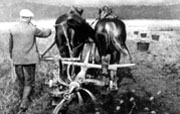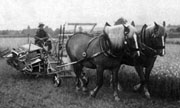 IIn the village there were craftsmen of all kinds, including bricklayers, carpenters, saddlers, shoemakers, smiths, and tailors. Consequently, all repairs could be made here along with the fabrication of new items. For example, my parents ordered a dining room table from carpenter Paul Haase. Shoemaker Stanelle didn't just repair shoes, he also sold new ones. We children often had the opportunity to watch the craftsmen at work, since it was our job to run errands for our family and neighbors. I myself enjoyed watching Mr. Stanelle repairing footwear, and Mr. Fabian shoeing horses.
IIn the village there were craftsmen of all kinds, including bricklayers, carpenters, saddlers, shoemakers, smiths, and tailors. Consequently, all repairs could be made here along with the fabrication of new items. For example, my parents ordered a dining room table from carpenter Paul Haase. Shoemaker Stanelle didn't just repair shoes, he also sold new ones. We children often had the opportunity to watch the craftsmen at work, since it was our job to run errands for our family and neighbors. I myself enjoyed watching Mr. Stanelle repairing footwear, and Mr. Fabian shoeing horses.
 The railway played an important role in the village economy, moving passengers as well as freight. Paschkerwitz was conveniently situated between the provincial capital, Breslau, and the district capital of Trebnitz, which made it possible to travel to jobs and higher education in other places. Every day, there were 12 trains stopping in Paschkerwitz to serve local people as well as others from Langenau and Hartwasser. The last station master was Mr. Gustav Frost, whose predecessor, Mr. Alfred Moch, still lived in the station building after his retirement.
The railway played an important role in the village economy, moving passengers as well as freight. Paschkerwitz was conveniently situated between the provincial capital, Breslau, and the district capital of Trebnitz, which made it possible to travel to jobs and higher education in other places. Every day, there were 12 trains stopping in Paschkerwitz to serve local people as well as others from Langenau and Hartwasser. The last station master was Mr. Gustav Frost, whose predecessor, Mr. Alfred Moch, still lived in the station building after his retirement. A
A Animal farming was also important here. All farmers kept cows, horses, pigs, and poultry. The milk was taken daily by train to the dairy. The horses were not only used to pull the wagons and sleighs but to plough the fields and perform a variety of other tasks. On the estate, oxen were also used for pulling heavier loads. Although draught animals were still important, machines were beginning to be utilized. Steam power had been used for plowing and threshing on the estate for some time. In the early 1940s, I saw my first tractor in Paschkerwitz. This machine was operated by a French prisoner of war because no one else on the estate was qualified.
Animal farming was also important here. All farmers kept cows, horses, pigs, and poultry. The milk was taken daily by train to the dairy. The horses were not only used to pull the wagons and sleighs but to plough the fields and perform a variety of other tasks. On the estate, oxen were also used for pulling heavier loads. Although draught animals were still important, machines were beginning to be utilized. Steam power had been used for plowing and threshing on the estate for some time. In the early 1940s, I saw my first tractor in Paschkerwitz. This machine was operated by a French prisoner of war because no one else on the estate was qualified.  IIn the village there were craftsmen of all kinds, including bricklayers, carpenters, saddlers, shoemakers, smiths, and tailors. Consequently, all repairs could be made here along with the fabrication of new items. For example, my parents ordered a dining room table from carpenter Paul Haase. Shoemaker Stanelle didn't just repair shoes, he also sold new ones. We children often had the opportunity to watch the craftsmen at work, since it was our job to run errands for our family and neighbors. I myself enjoyed watching Mr. Stanelle repairing footwear, and Mr.
IIn the village there were craftsmen of all kinds, including bricklayers, carpenters, saddlers, shoemakers, smiths, and tailors. Consequently, all repairs could be made here along with the fabrication of new items. For example, my parents ordered a dining room table from carpenter Paul Haase. Shoemaker Stanelle didn't just repair shoes, he also sold new ones. We children often had the opportunity to watch the craftsmen at work, since it was our job to run errands for our family and neighbors. I myself enjoyed watching Mr. Stanelle repairing footwear, and Mr.










